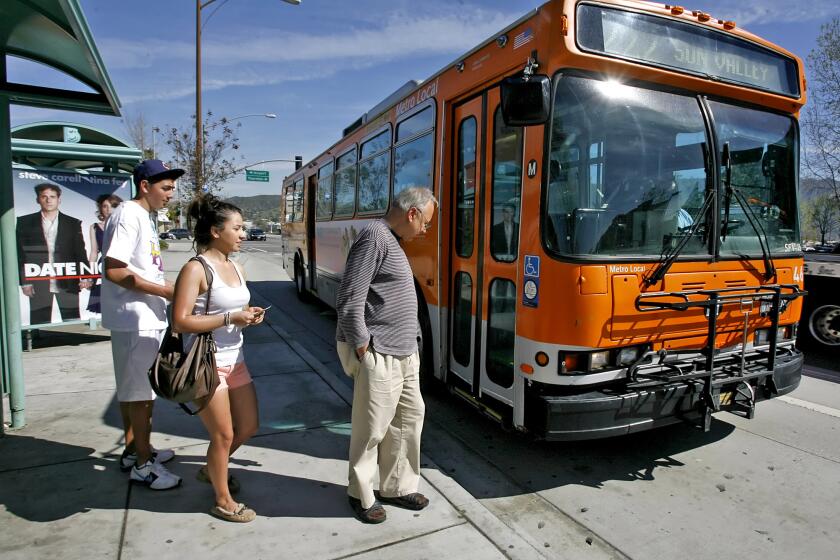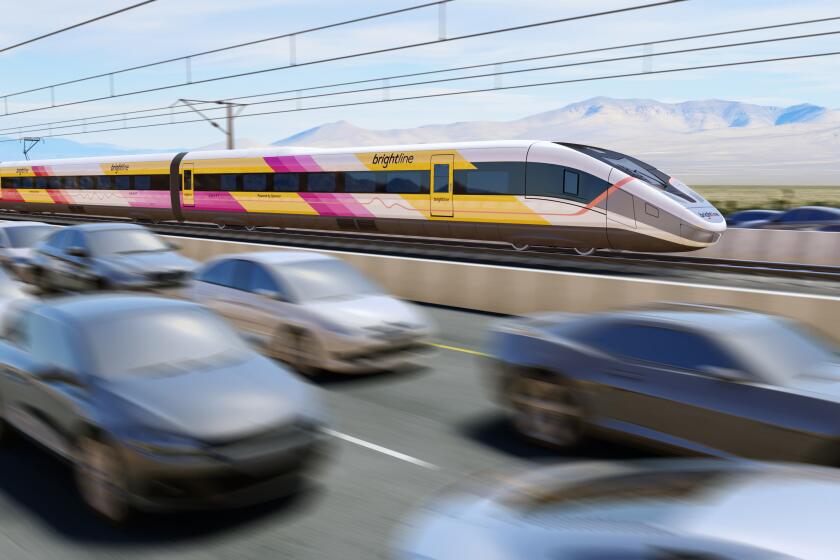Day of Reckoning for MTA on Whether to Delay Rail Lines
Within sight of the Metropolitan Transportation Authority’s gleaming 26-story headquarters sits a pile of unused rail long enough to stretch nine miles--if it ever gets laid.
Nearby, gathering dust, stands a $13-million bridge intended to carry the unbuilt downtown-to-Pasadena trolley line over the Los Angeles River. Farther north, in Pasadena, a building constructed with a hole through its center to accommodate a future trolley station is emblazoned with a sign reading: “Tell MTA to complete the job.”
Today, the agency’s board is scheduled to vote on whether that job and others will be indefinitely put on hold. A majority of the MTA’s directors appear to support transit chief Julian Burke’s proposal to finish subway construction to North Hollywood by 2000, while suspending work on rail lines to the Eastside, Mid-City and Pasadena. Work on promised rail lines across the San Fernando Valley, through the Crenshaw district and down Exposition Boulevard from USC to the Westside already have been deferred while planners study building high-capacity busways instead.
Burke, the 70-year-old corporate turnaround artist brought to the MTA by its board chairman, Los Angeles Mayor Richard Riordan, has recommended that the agency take a six- to 18-month “breather” from its ambitious rail construction program--one of the nation’s largest public works projects.
“We can only do so many things,” Burke said in an interview. “We have to have some relief from all of the burdens of management and expense that we have while we pause and look at what our resources are.”
MTA board member Larry Zarian thinks that may be a good idea. “We’ve had gourmet restaurant taste,” he said. “It’s time we look at cafeteria food.”
Shutdown Expenses
That is not to say that the MTA is going on a rail-free diet. The Eastside, Mid-City and Pasadena lines may still be built but face further delays. Some officials believe that the board may have to reduce the length and number of stations on the Eastside and Pasadena routes. One staffer said it may be necessary to keep the projects going but scale them back and stretch them out to preserve state and federal funding, which Washington is withholding until the MTA produces a recovery plan that federal authorities deem fiscally sound.
In addition to the $300 million already spent on the lines, MTA officials say they may need another $5 million in “demobilization” costs just to shut down work. That would cover the penalties for canceling equipment and materials ordered for the projects. A work stoppage is expected to lead to more layoffs at the agency.
“We have a very large investment in these projects,” Allan Lipsky, MTA’s deputy chief executive officer, said Tuesday. “The purpose of the demobilization plan and the suspension was to preserve the investment while we are rethinking whether those projects will resume.”
Burke said in a report to the board that he considered alternatives to suspending the projects but none would satisfy U.S. transportation officials’ demands “that the agency’s financial and managerial problems be fully resolved before funding could resume.”
County Supervisor and MTA board member Zev Yaroslavsky said the board needs to make tough decisions before outside financial and political forces make decisions for them. “The only thing that will inspire confidence in Washington, on Wall Street and among the L.A. County taxpayers is a painful decision,” one in which the MTA “doesn’t continue to be all things to all people.”
One of those outside forces is Yaroslavsky’s threat to sponsor a ballot initiative cutting off local sales tax funding for subway construction beyond North Hollywood.
Some board members say the MTA can no longer afford building a $300-million-per-mile subway. Riordan agrees but has said that an underground route appears to be the “only feasible way” to go east of downtown. Planners say the land acquisition for an aboveground system would be just as costly, if not more so.
If the MTA changes its plans for the rail lines, it would not be the first time that Los Angeles has suffered from a case of mass transit confusion. Symbols of abandoned projects or unfulfilled promises abound.
There is the small, unfinished stub of concrete guideway that points to Los Angeles International Airport on the Green Line--best known not for where it goes but where it doesn’t. There is the “tunnel to nowhere,” a 1,500-foot Bunker Hill tunnel built at a cost of $29 million for a “people mover” project that was killed by a budget-conscious Reagan administration in 1981.
Burke said there “certainly is a possibility” that some of the rail lines would be abandoned. But he added: “I don’t go into this with a view that any of them should be. But I do understand as we go forward, we will have much more sense about what we can do.”
Los Angeles City Councilman Richard Alatorre, an MTA board member who has pushed hard for a subway extension to his Eastside district, wants the MTA to study whether money can be found to keep the project moving, or whether construction can proceed, at least initially, on a shorter segment, an aide said.
“The whole idea of an indefinite suspension scares the hell out of everybody,” said an aide to another board member, expressing concern that Los Angeles could lose $450 million in federal money committed to the Eastside subway project.
Similarly, supporters of the downtown-to-Pasadena line say that the $800-million project--promised as long ago as 1980, when county voters approved the first of two half-cent sales tax increases to fund transit and which was supposed to be open by now--is too far along to stop. As now envisioned, the 13.6-mile line would run from Union Station through Chinatown, Lincoln Heights, Highland Park, South Pasadena, Old Pasadena and down the center of the Foothill Freeway to east Pasadena.
Land for the train tracks and the stations has been purchased. The MTA has bought and received 1,700 tons of rail and is expected to receive delivery of another 5,300 tons by the end of March at a total cost of about $5 million. About 34,000 concrete railroad ties purchased for $12 million are stacked on top of each other and stored at the end of the proposed line. The bridge over the L.A. River has been built, and rail cars have been purchased for the Pasadena line.
Operations Shortfall
Excavation on the Eastside line--a $1-billion, 3.5-mile extension of the subway from Union Station to Boyle Heights--was supposed to begin later this year.
Design is nearly complete. Buildings along the route have been purchased and about 100 families have been relocated. A 1,200-foot, 50-ton crossover for the trains, purchased at a cost of $400,000, sits in a Long Beach yard.
And the first of 14 subway cars purchased for $28 million for the Eastside line are being manufactured in Italy and are due to begin arriving in San Francisco this summer for final assembly before shipment to Los Angeles.
The Mid-City subway extension is much further behind the others. The $490-million, 2.3-mile project--to take the subway from Wilshire Boulevard and Western Avenue to Pico and San Vicente boulevards--is seven years behind schedule. Work was held up after the discovery of hydrogen sulfide gas beneath the ground led to a new study of the route.
Even if the MTA never lays another inch of track, the agency faces a projected $465-million shortfall just to maintain its existing bus and train operations over the next six years. On top of that, the agency is $727 million short of the money needed to build the rail lines on the current schedule.
Burke is concerned that until the MTA improves its operations, its hands are full with completing the subway to North Hollywood. Put another way, the MTA is like a parent having enough trouble caring for twins. Now is not the time to have triplets.
“If we’re struggling to finish North Hollywood on time and on budget, it’s a stretch for management to commit to doing a second, or a third or a fourth project,” said an aide to an MTA board member.
Supporters of the lines worry that a lengthy delay would cost the MTA state and federal funds promised for the lines.
Burke has talked to federal officials, including Transportation Secretary Rodney Slater, in hopes of ensuring that any delay in the rail projects would not jeopardize federal funds promised to Los Angeles for subway construction. In the interview, he said he has received encouragement but no assurances. A spokesman for the Federal Transit Administration said the agency would have no comment until after the board acts.
Burke’s salvage plans contain the seeds of a new quarrel: Although the debate has been framed as bus versus rail, there is not enough money to keep the subway project on track and fund many of the street and highway improvements proposed by cities.
Burke has proposed that $207 million in newly allocated state funds be used to fund subway construction to North Hollywood. Jeff Long, public works director for the city of Lancaster--which wants some of the state money for a street widening project--said the state legislation providing the funds was never intended to be a “bailout” of the subway project.
Some supporters of the Pasadena line believe that more of the state money should be used to keep the unfinished rail projects on track before funding new projects.
“They have spent $212 million on the Pasadena Blue Line and are willing to suspend it, without knowing when or if it will be started again,” said Cynthia Kurtz, Pasadena’s public works and transportation director. “At the same time, they are starting to fund new projects. That seems to be totally illogical.”
More to Read
Start your day right
Sign up for Essential California for news, features and recommendations from the L.A. Times and beyond in your inbox six days a week.
You may occasionally receive promotional content from the Los Angeles Times.






